Woodbury
Continued to: Woodbury (1910-1940)
John H. Woodbury was born in Salem, New Hampshire in 1851. His family moved around quite a lot as his father moved through various occupations. Census information puts the Woodbury family in Lowell, Massachusetts in 1855, back in Salem in 1860, then Methuen, Massachusetts in 1865, before being listed in Albany, New York in 1870 with John Woodbury, now aged 18, employed as horse car conductor.
Woodbury often gave 1870 as the founding date for his chiropody business so it would appear that he did not remain as a conductor or take up a position in his father’s shoe-making business. He also claimed to have been formerly with Dr. N. Kenison of Boston which, I assume, refers to Nehemiah Kenison [1824-1891], generally considered to be the father of podiatry/chiropody in the United States. There is an 1871 record of Woodbury living at 58 Temple Place, Boston, so it seems likely that he quit his job as a horse car conductor in 1870, moved to Boston and started working as a chiropodist with Kenison.
The first advertisement I have for Woodbury as a chiropodist is from Lowell, Massachusetts in 1874. He was only there for three days and the following year we find him back in Albany. Initially, he was located at 40 North Pearl Street but he moved his business to 39 North Pearl Street in 1876.

Above: 1876 Dr. J. H. Woodbury Surgeon Chiropodist.
By 1880, Woodbury had moved next door to 37 North Pearl Street and he remained there until he left for New York in 1889. By then, his business had grown to encompassed six parlours, three specifically for ladies.
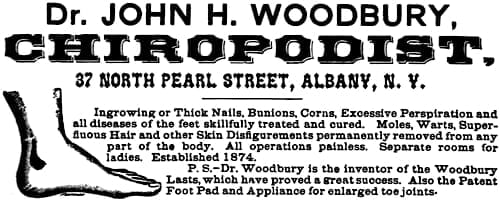
Above: 1880 Dr. John H. Woodbury Chiropodist.
Some of the growth in Woodbury’s business was because he had extended his practice beyond feet. In the 1880s he began treating a wide range of ‘skin disfigurements’, adding dermatologist to his advertisements in 1883. By then, he had also published a book – ‘Disfigurements and imperfections of the skin and their treatment’ – that could be mailed on request for 10 cents. Woodbury frequently revised it and it had gone through at least four editions by 1889.
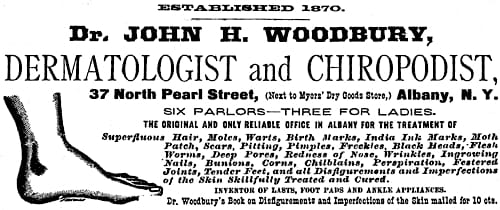
Above: 1883 Dr. John H. Woodbury Chiropodist and Dermatologist.
Treatments available in the Albany practice included using astringents to relieve red noses, ‘penetrating oils’ and massage to break up and soften scars, electrolysis treatments for removing superfluous hair and other problems such as moles and warts, and skin peels to remove deep-seated skin conditions like pockmarks and birthmarks.

Above: 1884 Dr. John H. Woodbury treatments for superfluous hair.
Electrolysis was a relatively new procedure in the 1880s but had been adopted by numerous lay practitioners as well as doctors, so the practice was well established.
See also: Electrolysis
Skin peeling was less common and was a risky procedure at best. I do not know what chemicals Woodbury used in his skin peels but he would later sell a product he called Dermaform which appears to have been used to induce peeling. It was only to be used by a physician but could be used to remove birthmarks, red veins, cancers, moles, warts, gunpowder marks, and other pigmentary or vascular disfigurements.
See also: Face Skinning
Dermatological Institute
Woodbury had married Ada Kelly [1856-1878] in 1877 but, tragically, she died the following year. In 1882, he entered into a second marriage with Cora Landon [1861-1952], an older sister of Seth Eldrege Landon [1866-1891] one of Woodbury’s assistants. They would later separate.
When Woodbury moved to New York in 1889, Seth Landon bought the Albany business from him. When Seth Landon died from ‘catarrh of the stomach’ in 1891 the Albany business then passed to John H. Callahan [1871-1953] another Woodbury employee.
Arriving in New York City, Woodbury established a temporary practice at 210 West 42nd Street but soon moved to a brownstone at 125 West 42nd Street. This became the base for the John H. Woodbury Dermatological Institute founded by Woodbury and others in 1890 (capital US$1,000). As the major shareholder, Woodbury was made president of the company and Cora became one of its trustees.
Expansion
Following the founding of the Dermatological Institute, Woodbury began expanding the products and services he offered including new cosmetics and toiletries, additional electrical treatments and plastic surgery. Woodbury also opened new Dermatological Institutes, creating branch offices in Boston, Philadelphia, Chicago and St. Louis in 1894, although the St. Louis office was closed by 1897.
Advertising was a key part of this expansion and Woodbury outlaid a great deal of money to promote his products and other services, spending US$75,000 in 1891, US$150,000 in 1892, and US$100,000 in 1898 (Denkler & Hudson, 2015, p. 879). Many Woodbury advertisements included the neckless head trademark and this was also used prominently on Woodbury packaging.
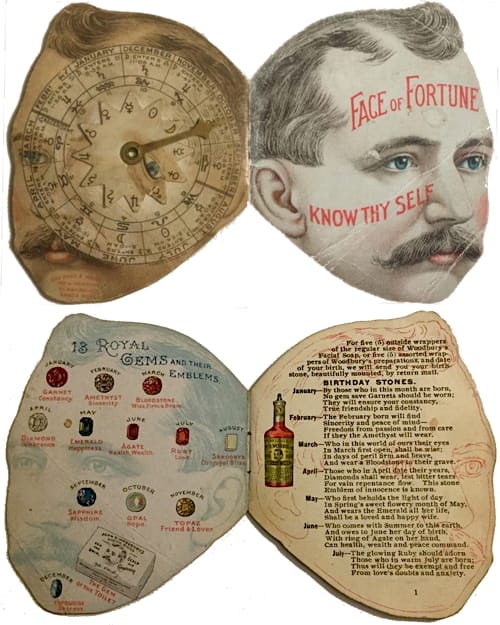
Above: c.1898 Parts of the Woodbury Face of Fortune booklet which included an offer of a birthstone in exchange for five Woodbury product wrappers and an astrological calculator.
Cosmetics and toiletries
Woodbury had been selling a Facial Soap for some time, perhaps as early as 1881 (Cardwell, 1914, p. 9), but only began advertising it after he established the Dermatological Institute in New York. Woodbury claimed that the soap contained an antiseptic but, if it did, I have been unable to determine its nature.
Woodbury Facial Cream, a type of vanishing cream, and Woodbury Facial Powder were added in 1891, followed by Woodbury Antiseptic Shaving Sticks and Bars, Woodbury Hair and Scalp Tonic, Woodbury Dental Cream, and Woodbury Odorine, a deodorant.
Facial Soap: “[R]ecommended by physicians, being pure, antiseptic, medicinal. It is the only soap that will clear the skin of pimples, blackheads and eruptions of any nature.”
Facial Cream: “[H]ighly perfumed, contains no gum, oil or grease. Its use will not cause a superfluous growth of hair, and for tan, freckles, eczema and all mild cutaneous afflictions it is highly recommended.”
Facial Powder: “[H]armless, transparent, and when used is invisible. It is made by a dermatologist who has had over 26 years’ practical experience treating skin diseases, and can be relied upon to contain nothing to irritate or cause a blemish of any nature on the skin.” Shades: Flesh, White, Pink, and Cream.
Antiseptic Shaving Sticks and Bars: “Impossible to contract a skin disease when used. Insist on your barber using it when shaving you.”
Hair and Scalp Tonic: “[R]emoves scurf, scales and dandruff from the scalp, prevents the falling of the hair, stimulates its growth and restores the lustre. It can be used with advantage by both young and old. Its use does not stain the scalp or clothing.”
Dental Cream: “[I]ndorsed by the dental profession, is strictly vegetable, and a most agreeable medium for cleaning the teeth, arresting and preventing decay, and imparting to the gums that high color and firmness indicative of their health. It is put up in tubes, which makes it convenient to use at home or when travelling.”
Odorine: “[S]oothes and sweetens the feet and arm pits.”
Electrical treatments
As previously noted, Woodbury had been using electricity in dermatological treatments for years, most notable electrolysis to permanently remove superfluous hair. He also began using faradic machines, commonly used to develop muscles by ‘exercising’ them with electrical contractions, and had also installed a large machine to provide static electrical treatments for a range of disorders including rheumatism, neuralgia, sciatica, gout, and nervous diseases.
FARADIC GALVANIC ELECTRICITY.
Applied by regular specially qualified Physicians at the John H. Woodbury Dermatological Ins’t for Gout, Neuralgia, Insomnia, Sciatica, Rheumatism, Spinal Troubles, Nervous Diseases, Paralysis, Dyspepsia, Stomach, Liver, Kidney Disorders, Facial Blemishes, Blood, Skin, and Scalp Diseases, with the Largest, Finest, up to date Electric Machines and Appliances, Toning, Invigorating the System and developing the Muscles without removing or disarranging the Clothing.
Consultation Free.(Woodbury advertisement, 1895)
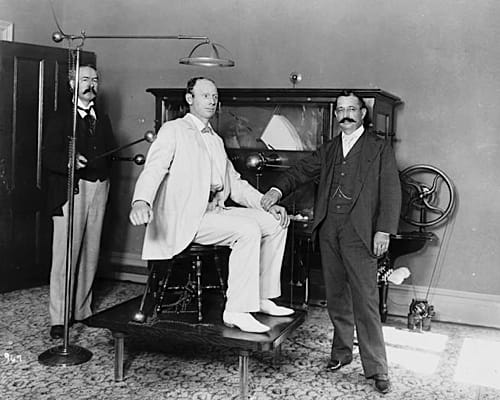
Above: 1895 Prizefighter Robert James Fitzsimmons [1863-1917] having a whole body electrostatic treatment from Dr. John Wilson Gibbs (left) with John H. Woodbury (right) taking his pulse.
See also: Galvanic Treatments and Faradic Treatments
Plastic surgery
Woodbury is well known in medical circles for the range of plastic surgery procedures for the nose, eyes, lips, and ears that he introduced in the 1890s.
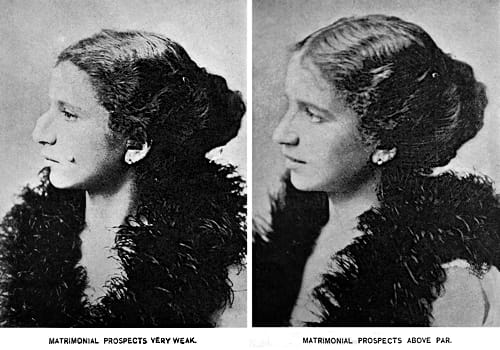
Above: 1895 Before and after photographs of Woodbury surgical procedures.
Advertisements Woodbury placed to promote these plastic surgery procedures often included descriptions on how the surgery was accomplished. As well as drawing patients to the Dermatological Institutes, these advertisements added to Woodbury’s credibility as a dermatologist which would have helped increase sales of Woodbury products.
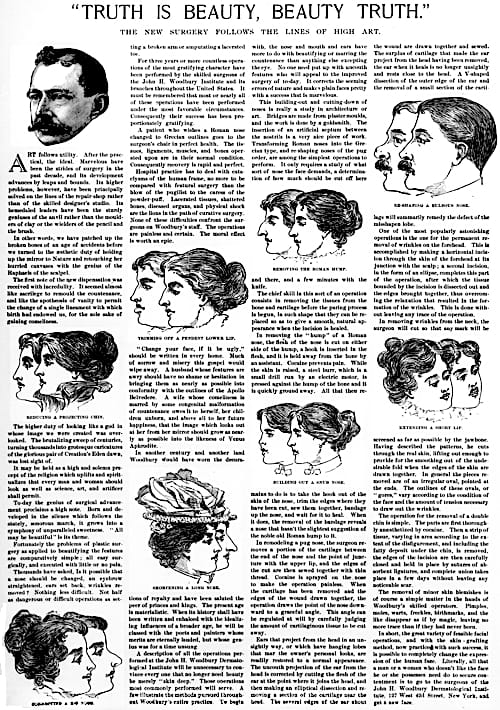
Above: 1898 Woodbury advertorial listing a range of surgical procedures: Reducing a projecting chin; Correcting a pug nose; Trimming off a persistent lower lip; Shortening a long nose; Removing the Roman hump; Building out a snub nose; Reshaping a bulbous nose; and Extending a short lip.
Woodbury had stopped referring to himself as a doctor by the time he moved to New York and relied on others to conduct most of the surgical procedures. Denkler & Hudson report there were 15 physicians employed in the New York Institute in 1894 with the number rising to 25 after he opened institutes in other American cities (Denkler & Hudson, 2015, p. 879).
Individuals unable or unwilling to undergo surgery could buy mechanical devices from Woodbury to reshaping their nose or make their protruding ears less obvious.
Many a face is marred by what is commonly called lop or projecting ears. In many cases this is caused by men wearing their caps pulled down so as to press upon the ears, these being very elastic or pliable, rapidly change their form and begin to project from the head, and if this pressure continues any length of time it soon bends the ear. This may often be observed in females, having been caused by the practice of placing the hair behind the ears in childhood. Many other cases are inherited. The disfigurement is remedied by a mechanical appliance holding the ears in their proper shape. It is worn at night, without inconvenience or pain, and will soon bring the ears to their natural position.
(Woodbury, 1894, p. 40)
Levels of treatment
Cosmetics and toiletries, electrical treatments and plastic surgery enabled Woodbury to provided different levels of treatment for ‘skin disfigurements’. For example, small wrinkles could be treated with a ‘penetrating oil’ and his Facial Instrument. Deeper wrinkles required electrical treatments but the most severe problems needed surgery to correct them, done using cocaine as a local anaesthetic.

Above: Woodbury Facial Instrument.
The twenty years of experience and study devoted to Dermatology by John H. Woodbury have been rewarded by wonderful results. The possibilities of the science have been brought down to a very fine point, so that moles, pockmarks, birthmarks, scars, all vanish as if by magic under his treatment, which, by the skilful use of Cocaine, he has rendered painless.
The several methods of removing wrinkles are wonderful, efficacious and simple when you know about it.
He can smooth out many furrowed skins by means of a penetrating oil, acting in conjunction with a clever little machine called the Facial Instrument. But for the removal of deep, horizontal and vertical lines on the forehead and between the brows caused by the disfiguring habit most people have of frowning, either electricity or a surgical operation is usually necessary.
This sounds alarming, but it need not be in the least so. The surgeons in the John H. Woodbury Dermatological Institute are all highly qualified medical men, with an accurate knowledge of their business and the practical experience of many years.(Woodbury advertisement, 1895)
See also: Straps Bandages and Tapes
Although they were not widely advertised, Woodbury sold a number of patent medicines including Anti-Constipation Pills, Anti-Corpulent Pills, and a Nerve Tonic. In additionm there were Compound Arsenic Tablets, believed to make the skin look pale, and Pennyroyal pills, widely used for mensural problems or as an abortifacient.
See also: Patent Medicines and Cosmetics and Arsenic-Eaters and Cucumber Creams
Also offered for sale were a number beautification devices which were also used in beauty salons of the period, including a Toilet Mask or Face Glove, and a device for steaming the face.
See also: Vaporisers (Steamers & Atomisers) and Patters
Andrew Jergens
In 1897, the Andrew Jergens Company of Cincinnati took over the manufacture and sale of two of Woodbury’s best selling lines – Woodbury Facial Soap, and Facial Cream
In 1901, Andrew Jergens then bought the rights to the neckless head trademark, and the name Woodbury in connection with eight Woodbury toilet articles – Woodbury Facial Soap, Shaving Soap, Shaving Stick, Facial Cream, Facial Powder, Dental Cream, Tooth Powder and Odorine Powder – for US$212,500.
Andrew Jergens also bought 50 shares in the Dermatological Institute for US$250,000 giving it a 50% stake in the company. The remaining 50 shares were owned as follows: John H. Woodbury (30 shares), William Albert Woodbury, Woodbury’s cousin (19 shares), and Payton R. McCargo (1 share). McCargo had acquired his single share in 1898 when Woodbury made him a director. In 1904, Andrew Jergens bought McCargo’s share, replaced his seat on the board with an Andrew Jergens’ representative, and gained control of the company.
After purchasing the rights to Woodbury’s Facial Soap, Andrew Jergens began to emphasise its ability to beautify the skin rather than its quasi-medical features, an appraoch reinforced by the increased use of images of women in Woodbury advertisements.
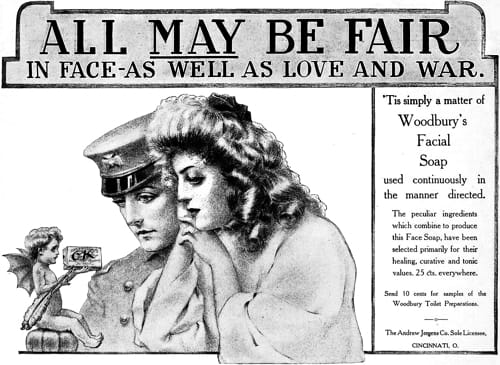
Above: 1905 Woodbury Facial Soap.
It is something of a mystery why John H. Woodbury sold of most of his business and his best selling lines. It seems clear that he did not plan to retire, as he set up the Woodbury-McGrath Company in conjunction with Peyton R. McCargo. In 1907, he followed this by founding the Facial Cultivating Company which also involved his nephew William A. Woodbury [1866-1957]. Some of the products produced by the Facial Cultivating Company, such as the New Skin Soap, overlapped products Woodbury had sold to Andrew Jergens in 1901, leading Andrew Jergens to take legal action. This began the first of a long series of court cases over Woodbury trademarks that continued for decades to come.
John H. Woodbury was not involved in these cases as he had committed suicide in 1909. Exactly why is unclear. He was a wealthy man when he died but had been drinking heavily before he shot himself with a his revolver. He was buried with his first wife.
Timeline
| 1874 | Woodbury established a chiropodist practice in Albany, New York State. |
| 1881 | New Products: Facial Soap. |
| 1889 | Woodbury sells his Albany practice and moves to New York City. |
| 1890 | John H. Woodbury Dermatological Institute founded. |
| 1891 | New Products: Facial Cream; and Facial Powder. |
| 1893 | New Products: Antiseptic Barbers Bars; and Antiseptic Shaving Stick. |
| 1894 | Dermatological Institutes opened in Boston, Philadelphia, and Chicago. |
| 1895 | Andrew Jergens begins manufacturing Woodbury Facial Soap. |
| 1901 | Andrew Jergens acquires Woodbury products and trademarks and 50% of the Dermatological Institute. |
First Posted: 1st June 2023
Continued to: Woodbury (1910-1940)
Sources
The American perfumer & essential oil review. (1906-1955). New York: Robbins Perfumer Co. [etc.].
Denkler, K. A. & Hudson, R. F. (2015). The 19th century origins of facial cosmetic surgery and John H. Woodbury. Aesthetic Surgery Journal, 35(7), 878-889.
Woodbury, J. H. (1894). What dermatology has to do with beauty: How to remove all imperfections of the skin. New York: Fless & Ridge Printing Company.
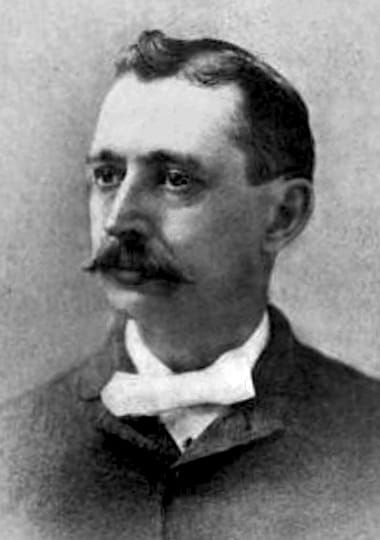
John Humphrey Woodbury [1851-1909].
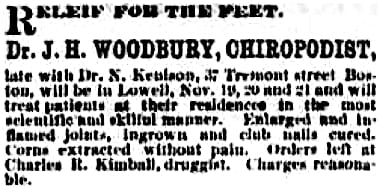
1874 Dr. J. H. Woodbury, Chiropodist.
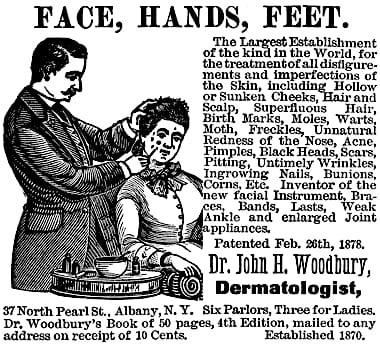
1888 Dr John H. Woodbury, Dermatologist.

Drawing from a patent for an Instep Holder invented by Woodbridge (US200,785, 1878).
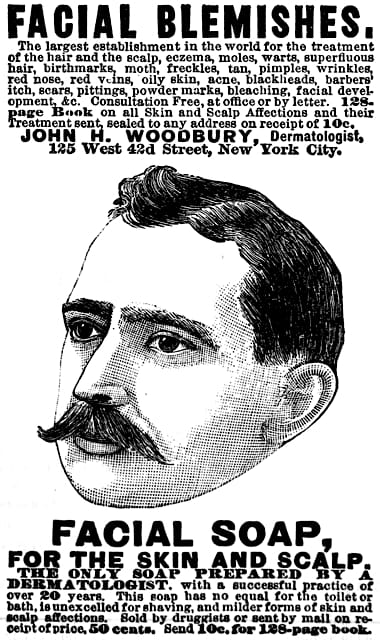
1890 Woodbury Facial Soap at 125 West 42nd Street.
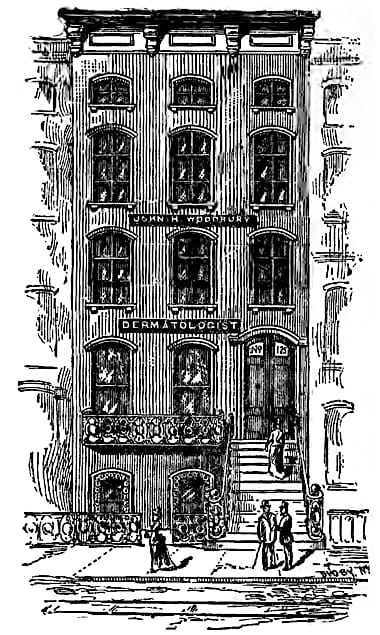
John H. Woodbury Dermatological Institute at 125 West 42nd Street, New York. The operating room was on the first floor, advertising department on the second, with the mail order department and laboratory in a separate building at the rear.
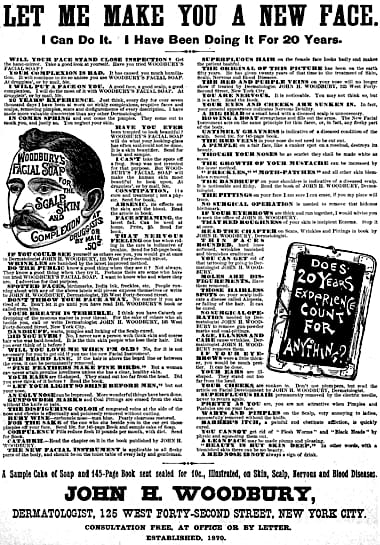
1892 John H. Woodbury Dermatologist.
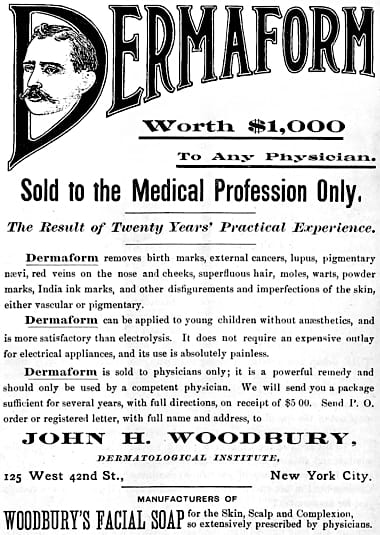
1892 Woodbury Dermaform.
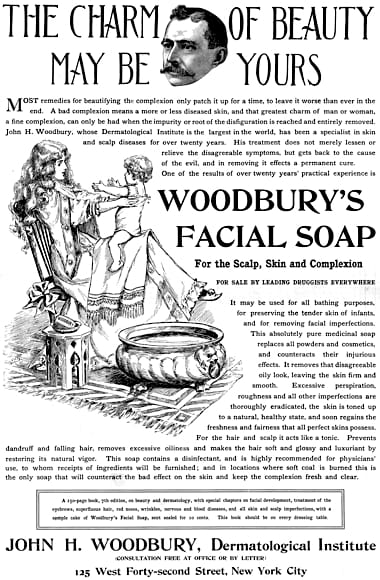
1893 Woodbury Facial Soap.

1894 John H. Woodbury’s terms for preparing special treatment for patients living at a distance.

1895 Woodbury electrical treatments.
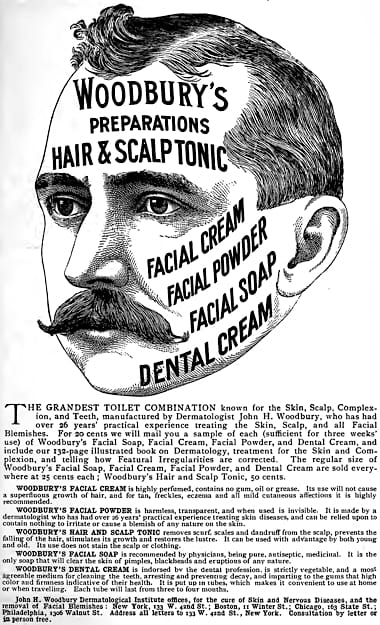
1897 Woodbury Hair & Scalp Tonic, Facial Cream, Facial Powder, Facial Soap, and Dental Cream.
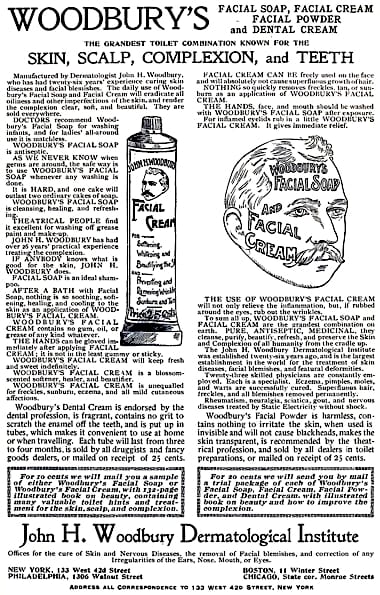
1897 Woodbury Facial Soap, Facial Cream, Facial Powder, and Dental Cream.
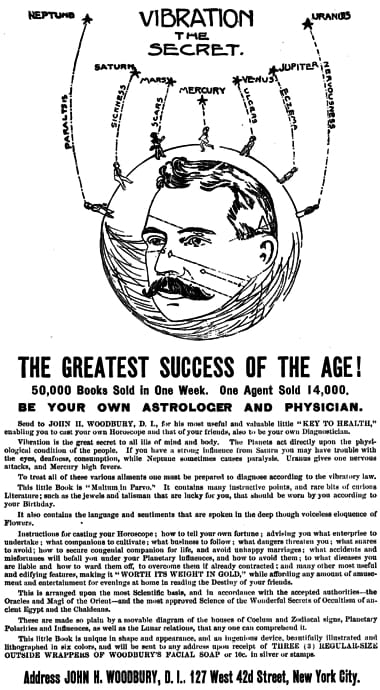
1898 Vibration the Secret.
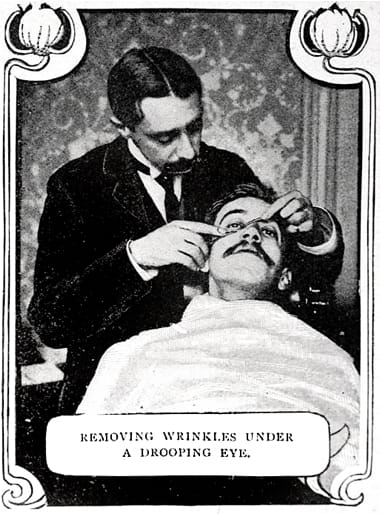
1902 Removing wrinkles under the eyes. Surgical procedures on men conducted in London using techniques developed by Woodbury.
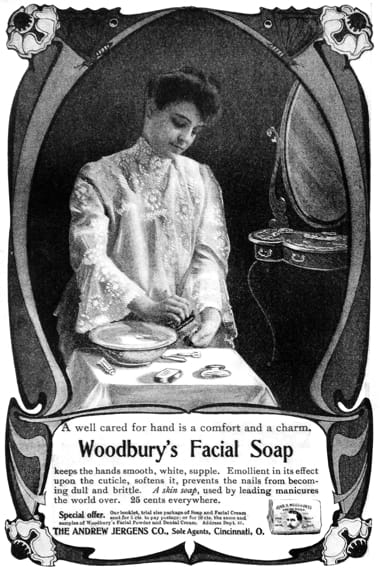
1903 Woodbury Facial Soap.
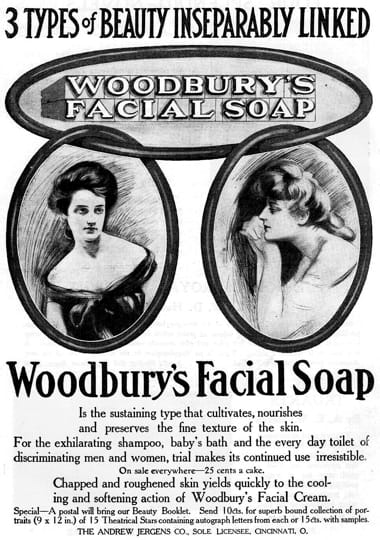
1905 Woodbury Facial Soap.
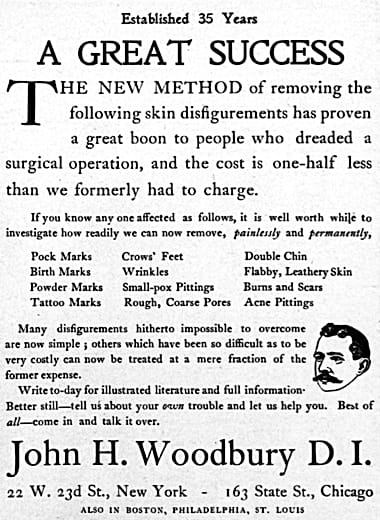
1905 John H. Woodbury D. I.
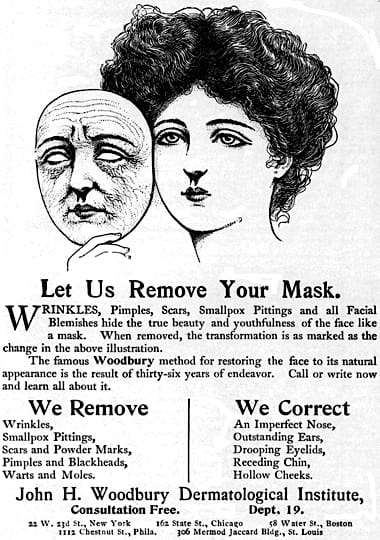
1906 John H. Woodbury Dermatological Institute.
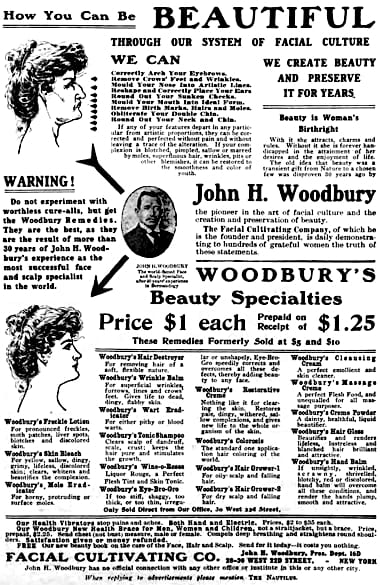
1907 Facial Cultivating Company.

John H. Woodbury buried with his first wife Ada A. Woodbury.
